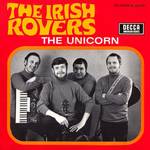The Unicorn (song) facts for kids
Quick facts for kids "The Unicorn" |
|
|---|---|

Decca 32254
|
|
| Single by The Irish Rovers | |
| from the album The Unicorn | |
| B-side |
|
| Released | 1968 |
| Genre | Folk |
| Length | 3:18 |
| Label | Decca (most releases) MCA (UK/Ireland) Festival (Australia) |
| Songwriter(s) | Shel Silverstein |
| Producer(s) | Charles "Bud" Dant |
| "The Unicorn" | |
|---|---|
| Song by Shel Silverstein | |
| from the album Inside Folk Songs | |
| Released | 1962 |
| Genre | Folk |
| Label | Atlantic Records |
| Songwriter(s) | Shel Silverstein |
| Producer(s) | Jerry Wexler, Al Brackman |
"The Unicorn" is a popular folk song. It was written by the famous American writer and poet Shel Silverstein. The song first came out in 1962 on his album Inside Folk Songs.
Contents
The Story Behind the Song
The words to "The Unicorn" are also printed as a poem in Shel Silverstein's well-known book, Where the Sidewalk Ends. This book is full of funny and thoughtful poems for kids.
In the original song, some parts are spoken instead of sung. For example, the very last line of the song is always spoken without music: "And that's why you'll never see a Unicorn to this very day." You can still hear this song played often in Irish pubs around the world.
The Irish Rovers' Hit Version
The song became super famous when the band The Irish Rovers released their version in 1968. It quickly became one of their most popular songs ever!
The Irish Rovers' recording of "The Unicorn" sold an amazing 8 million copies worldwide. In their home country of Ireland, the song reached number 5 on the music charts. It also did very well in other places: it was number 4 in Canada and number 7 on the Hot 100 chart in the United States.
Other Artists Who Sang It
Many other musicians have also recorded "The Unicorn" over the years. Here are a few of them:
- Bill Anderson
- Robert Goulet
- The Bachelors (an Irish trio)
- Will Millar, one of the members of The Irish Rovers, recorded an earlier version with a group called the St. Michaels Kids. He even opened an Irish pub called "The Unicorn" in Toronto!
- In 1968, the song was translated into other languages. A French version called "La Licorne" was recorded by Les Compagnons de la Chanson and Les Coquettes. A German version was sung by Andy Fisher.
- The Kidsongs Kids, who make videos for children, covered the song in 1986 for their video "Good Night, Sleep Tight." They left out the sad part of the story.
- In 2006, folk singers The Nields included the song on their album "All Together Singing In The Kitchen," which was made for their younger fans.
- The famous Australian children's band The Wiggles sang the song with Irish singer Morgan Crowley on their 2009 album The Wiggles Go Bananas!.
What the Song is About
The song tells a funny and slightly sad story about unicorns. It says that unicorns were not just make-believe creatures. Instead, they were real animals that missed their chance to get on Noah's Ark.
According to the song, when the Great Flood happened (a big flood described in the Bible), Noah gathered all the animals onto his Ark to save them. But the unicorns were too busy playing and being silly. They didn't get on the boat in time! The song describes them as the loveliest of all animals, but also a bit foolish. Because they missed the Ark, the song says that's why we don't see unicorns today.
An Alternative Ending
Later, a musician named Andrew McKee wrote new lyrics for the song. His version gives a different, happier ending for the unicorns. In his story, unicorns are magical creatures. When the Great Flood started, they grew wings and learned how to fly above the rising waters!
Andrew McKee's version suggests that to find unicorns, you should look for them "the second star to the right and straight on until morning." This famous line comes from the story of Peter Pan, which describes how to reach Never-Never Land.

